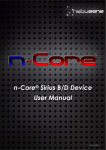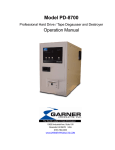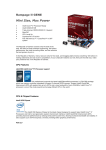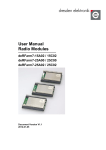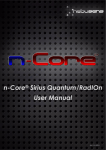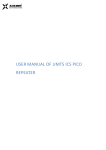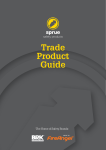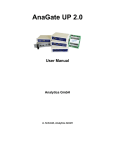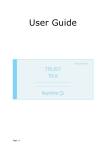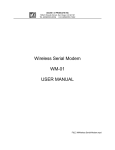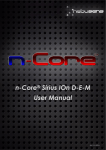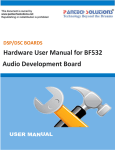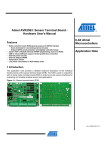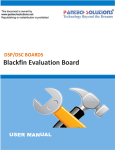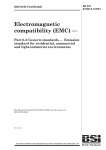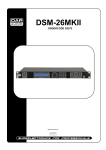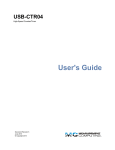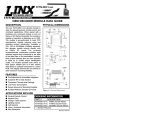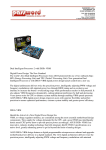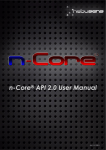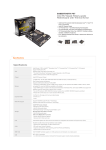Download n-Core® Sirius A Device User Manual
Transcript
n-Core® Sirius A Device User Manual Rev. 20130823 Sirius A User Manual Table of contents 1. Introduction ....................................................................................................................... 2 2. Technical features ............................................................................................................ 3 3. Pinout ................................................................................................................................. 4 4. Power supply ..................................................................................................................... 5 4.1. On/Off mode ................................................................................................................................................. 5 4.2. Reset ................................................................................................................................................................ 5 5. Input and output interfaces ............................................................................................. 5 5.1. GPO ................................................................................................................................................................. 6 5.2. GPI ................................................................................................................................................................... 6 5.3. ADC ................................................................................................................................................................. 7 5.4. I2C..................................................................................................................................................................... 8 5.5. SPI ..................................................................................................................................................................... 8 5.6. USART ............................................................................................................................................................... 9 5.6.1. USB ........................................................................................................................................................... 9 5.6.2. DB-9/RS-232 ............................................................................................................................................ 9 5.7. LED ................................................................................................................................................................. 10 6. Radio ................................................................................................................................ 10 7. Firmware updates ........................................................................................................... 10 8. Accessories ..................................................................................................................... 11 9. Recommendations of use and security ....................................................................... 11 10. Additional information ................................................................................................... 12 1 Sirius A User Manual 1. Introduction GPO GPI ADC I2C USART (USB) USART (RS-232) RELAYS (GPO) Sirius A is a radio frequency device that offers a total solution to build wireless networks based on the IEEE 802.15.4/ZigBee™ standard in a fast and easy way. Its robust design provides an extraordinary connectivity and versatility to adapt to a wide range of applications. It has several communication ports and input/output interfaces, which allows integrating a great number of external devices such as, for example, sensors, actuators or even computers, among others. Sirius A forms part of the n-Core® platform, developed by Nebusens. n-Core® offers a set of hardware and software tools capable for covering all your necessities of development and deployment of wireless networks based on the IEEE 802.15.4/ZigBee™ standard. For more information about the n-Core® platform, please visit www.nebusens.com 2 Sirius A User Manual 2. Technical features Independent power supply (DC IN) Mini-USB power supply Power switch Dimensions Model Frequency Flash RAM EEPROM External EEPROM Transceiver Frequency band Number of channels Channel spacing (USA) Maximum power transmission (software-controlled) Sensitivity Data transmission rate Transceiver Frequency band Number of channels Channel spacing Maximum power transmission (software-controlled) Sensitivity Data transmission rate UART through USB/DB-9 SPI I2C Master (pull-up) Programming port Opto-coupled digital outputs (x4) Opto-coupled digital inputs (x4) ADC (x2) Relay sockets (x2) UART through USB UART through DB-9 LED (x2) Electrical characteristics 5 – 9V 5V ON/OFF Physical characteristics 111.8 x 107.7 x 26.3 mm Micro-controller ATMEGA1281V 8MHz 128KB 8KB 4KB 256KB (AT25F2048) Radio 900MHz AT86RF212 868 to 868.6MHz (Europe) 902 to 928MHz (USA) 1 (Europe), 10 (USA) 2MHz +10dBm -110dBm 20 – 100Kbps (Europe) 40 – 250Kbps (USA) 2.4GHz AT86RF231 2405 to 2480MHz 16 5MHz +15dBm -101dBm 250Kbps Connectivity 1: Manual/SW selection 2: UART through USB/DB-9 10-pin connector Mini-JTAG TTL-CMOS compatible 0 – 5V, 50mA. Independent external power supply TTL-CMOS compatible 0 – 6V, 0 – 50mA 0 – 1.25V SPDT: N.C., COM, N.O. Test: 12V@2A Silabs CP2103 Virtual Com Port RS-232 (TXD, RXD, CTS, RTS, DTR) Green/Red 3 Sirius A User Manual 3. Pinout 1 2 3 4 5 6 7 8 9 10 11 12 13 14 15 16 17 18 19 Block E2 GPO_1 GPO_2 GPO_3 GPO_4 GPO_VCC_IN GND GND GPI_1 GPI_2 GPI_3 GPI_4 ADC_2 ADC_1 GND GND I2C SDA I2C SCL 5V IN GND 1 2 3 4 5 6 7 8 9 10 1 2 3 Block P2 3.3 V output (controlled) I2C SDA SPI_CLK I2C SCL SPI_MOSI ADC_3 SPI_MISO 3.3 V output (permanent) 3.3 V (USB-dependent) GND Block E1 (RLY1) COM N.C. N.O. 4 Block P6 1 2 3 4 5 6 7 8 9 10 1 2 3 TCK GND TDO 3.3 V output (permanent) TMS RESET N/C N/C TDI GND Block E1 (RLY2) COM. N.C. N.O. Sirius A User Manual 4. Power supply 18-19 Sirius A device has two alternatives for power supply: 2-pole connector in block E2 (pins 18-19): 5 – 9V DC. Type B-Mini USB connector in block E1: 5V DC. USB Both connections can be established simultaneously, without influencing in the normal operation of the device. 4.1. On/Off mode On/Off button of Sirius A device is placed in block E1. This switch allows eliminating completely the power supply of the device. 1. Device switched off 2. Device switched on 1 2 4.2. Reset Reset button of Sirius A device is placed in block E2. This button reinitiates the routines programmed in the device, without affecting data stored in EEPROM. 5. Input and output interfaces Sirius A device has the following input and output interfaces: 4 opto-coupled digital outputs (GPO) 2 relay ports (GPO) SPDT configuration 4 opto-coupled digital inputs (GPI) 2 software-configurable as IRQs 3 analog-to-digital converter (ADC) 2 general-purpose 1 in DC-IN 2 LEDs (green and red) 1 I2C bus (internal pull-up) 1 SPI bus 1 USART accessible from outside USB (Virtual Com Port) RS-232 (DB-9) All input and output interfaces available in Sirius A device are next described. 5 Sirius A User Manual 5.1. GPO Sirius A device has four general-purpose opto-coupled digital outputs (LTV847S1), accessible from the block E2 (pins 1 - 4). Voltage and current characteristics for each GPO are determined by the transistors of the opto-coupler LTV847S. Next, it is shown the connections for each of the outputs. IMPORTANT NOTE: In order to use the GPOs is necessary that reference pins (GND) of both the Sirius A device (block E2, pins 6 and 7) and the input device (for example, an actuator) are connected to each other. The GPO_VCC_IN (block E2, pin 5) is the union of all the collectors of the opto-transistors of the LTV847S. Each GPO output corresponds with the emitter of an opto-transitor of the LTV847S. In order to activate the GPO is necessary to supply a voltage between 3.3V and 5V (recommended) to GPO_VCC_IN input. This voltage will be transmitted to each GPO, considering the losses of each LTV847S opto-transistor. 5.2. GPI Sirius A device has four general-purpose opto-coupled digital inputs (LTV847S1), accessible from the block E2 (pins 8 - 11). GPI3 (pin 10) and GPI4 (pin 11) can be configured as external interruptions (IRQs). Voltage and current characteristics for each GPI are determined by the LEDs of the opto-coupler LTV847S. Next, it is shown the connections for each of the opto-coupled digital inputs. 1 http://www.us.liteon.com/downloads/LTV-817-827-847.PDF 6 Sirius A User Manual IMPORTANT NOTE: In order to use the GPI is necessary that reference pins (GND) of both the Sirius A device (block E2, pins 6 and 7) and the input device (for example, a sensor) are connected to each other. 5.3. ADC Sirius A device has three analog-to-digital converters. Two of them are accessible from the block E2. ADC_1 and ADC_2 are for general purposes (pins 12 and 13). ADC_0 is connected directly to DC-IN (pin 18), allowing the monitoring of the voltage used to power the device. The reference voltage of the microcontroller is 1.25V. The voltage range for ADC_Xexternal input is from 0V to 3.75V. Next, it is shown the connections of analog-to-digital converters accessible from outside in the block E2. This type of connection implies a difference between the voltage supplied to the external ADC input (ADC_Xexternal) and the voltage registered by the microcontroller in the internal ADC input (ADC_Xinternal). The relation between both is given by the expression: 𝑨𝑫𝑪𝑿𝒊𝒏𝒕𝒆𝒓𝒏𝒂𝒍 = 𝑨𝑫𝑪_𝑿𝒆𝒙𝒕𝒆𝒓𝒏𝒂𝒍 𝟑 A similar behavior is observed for the analog-to-digital converter (ADC_0) connected to the DC-IN power supply. Therefore, the relation between the power supply voltage and the voltage read at ADC_0 can be calculated as: 𝑨𝑫𝑪𝟎𝒊𝒏𝒕𝒆𝒓𝒏𝒂𝒍 = 𝑽𝑪𝑪_𝑰𝑵 𝟏𝟏 IMPORTANT NOTE: In order to use the ADC is necessary that reference pins (GND) of both the Sirius A device (block E2, pin 14) and the input device (for example, a sensor) are connected to each other. 7 Sirius A User Manual 5.4. I2C Sirius A device has an internally pulled-up I2C bus, accessible from the block E2 (pins 15 - 17) and from the internal block P2 (pins 2 - 4). Electrical and protocol characteristics of I 2C bus are determined by the specifications of the ATmega1281V®2 microcontroller. I2C_SDA (block E2, pin 16, and block P2, pin 2) and I2C_SCL (block E2, pin 17, and block P2, pin 4) lines have internal pull-up as is shown below: IMPORTANT NOTE: In order to use the I2C bus is necessary that reference pins (GND) of both the Sirius A device (block E2, pin 15) and the input device (for example, a sensor) are connected to each other. 5.5. SPI Sirius A device has a SPI bus, accessible from the block P2 (pins 3, 5 and 7). Electrical and protocol characteristics of SPI bus are associated to the specifications of the ATmega1281V ®3 microcontroller. IMPORTANT NOTE: In order to use the SPI bus is necessary that reference pins (GND) of both the Sirius A device (block P2, pin 10) and the input device (for example, a sensor) are connected to each other. 2 3 http://www.atmel.com/dyn/resources/prod_documents/doc2549.pdf (section 12.3.4 Alternate Functions of Port D, p. 83; section 30. Electrical Characteristics, p. 367). http://www.atmel.com/dyn/resources/prod_documents/doc2549.pdf (section 13.3.2 Alternate Functions of Port B, p. 79). 8 Sirius A User Manual 5.6. USART Sirius A device has a USART serial communications port, accessible from the block E1 through USB and RS-232 ports. USART can be used to communicate the Sirius A device with other devices that have serial communication capacities, for example, a PC. Likewise, USART can also be used to update the device firmware as described in Section 6 of this manual. Access to USART is exclusive for each port, so they cannot be used simultaneously. Selection of the active port is done through the switch SW2 (USB/DB-9). SW2 (Man/uC) must be always in position 0. Bit rate Data bits Parity Stop bits Flow control 9600 bps – 115200 bps 8 None 1 Hardware/None SW2 (Man/uC) 0 0 SW2 (USB/DB-9) 0 1 Selection USB DB-9 5.6.1. USB The USART1 of the ATmega1281V® microcontroller in Sirius A device is connected to USB port through Silabs USB-Serial converter, model CP21034. This port is recognized by the operating system, such as Windows®, as a virtual serial port (Virtual Com Port)5, and it allows supplying power to the Sirius A device simultaneously to the establishment of the communication with it. 5.6.2. DB-9/RS-232 The USART1 of the microcontroller ATmega1281V ® in Sirius A device is also connected to a DB-9 port through a levelconverter, allowing connections with any device that accomplishes RS-232 standard. Configuration of DB-9 port pins corresponds to a DCE (Data Circuit-terminating Equipment). Therefore, a null-modem cable is necessary in order to connect the Sirius A device to a PC. 1 2 3 4 5 6 7 8 9 4 http://www.silabs.com/support/pages/support.aspx?ProductFamily=USB%20to%20UART 5 http://www.silabs.com/products/mcu/Pages/USBtoUARTBridgeVCPDrivers.aspx 9 NC RXD TXD NC GND DSR RTS CTS NC Sirius A User Manual 5.7. LED Sirius A device has 2 LEDs placed in block E1. Green LED: connected to GPIO_1 of the microcontroller. Red LED: connected to GPIO_0 of the microcontroller. By default, LEDs are configured as detailed below: Red LED fast blinking: device is looking for a ZigBee™ network to join. Red LED sporadic blinking: device is sending Node Alive6 signals, which indicate that the device is connected to the ZigBee™ network. Green LED fixed on7: device is connected to a ZigBee™ network. When n-Core® locating functions are used, both LEDs remain switched off and blink simultaneously when the device sends a tags table6. 6. Radio Sirius A devices include a transceiver that implements the IEEE 802.15.4/ZigBee™ standard. The power of the signal can be configured by software, by means of n-Core® development API6. Types of antenna: Model SA2400: Internal ceramic antenna. Model SA900-1: Internal ceramic antenna. Model SA900-2: External antenna with RPSMA connector. Transceiver: Model SA2400: AT86RF231 + amplifier (up to +15dbm). Models SA900-1 and SA900-2: AT86RF212. 7. Firmware updates Sirius A firmware's updates optimize device performance, fix bugs and, in some cases, add new functionalities. In order to update the device's firmware in a safe way, please, download the n-Core® update package and follow the instructions of use carefully. The update package can be downloaded from the support section at www.nebusens.com IMPORTANT NOTE: during the firmware update, it is necessary to ensure the power supply in order to prevent any damage or data loss. See section 3 of this manual. 6 For further information, please, consult the n-Core® development API reference at www.nebusens.com 7 It is possible that both LED are turned off and the device is still connected to the ZigBee™ network. This could happen because of some routines loaded into the device. 10 Sirius A User Manual 8. Accessories The following accessories can be used along with Sirius A devices. 2, 3 and 11-pole connectors: Terminal block Weidmüller 3.81 pitch / Camden Electronics 3.81pitch (CTB92HE). External power supplies: Power supply through DC-IN: 5 - 9VCC@300mA + 2-pole connector Power supply through USB: Compatible with USB (>300mA). USB data cable: USB-A – Mini USB-B Cable. 9. Recommendations of use and security Please, follow the next indications in order to obtain the maximum performance and to use Sirius A device in a safe way: Avoid placing metallic objects near the device as far as possible. Architectonic elements, such as metallic walls, doors, railings, pipes, concrete walls, among many others, can affect signal quality and, therefore, the maximum distance of communication between devices. Do not wet the device. Do not store or make use of the device in atmospheres with a high humidity rate (70% as maximum). Do not expose the device to heat sources or directly to the sun. Avoid short-circuiting connections. Pay special attention to relay output connections, because it could cause a short circuit in the device to be controlled. Do not apply to the device voltages and currents out of maximum and minimum rates recommended in this manual (both in power supply and input/output ports, as well as communication buses). Use an appropriate external power supply. The product must only work with the type of power supply indicated in this manual. If you are not sure about the type of the required power supply, please consult the manufacturer. Avoid manipulating any element of the device not described in this manual, because the warranty could be invalidated and the equipment could be damaged permanently. Do not use this product in gas stations, fuel tanks, chemical plants or places where demolition operations are being carried out or near potentially explosive atmospheres, such as re-fuelling areas, fuel tanks, under boat decks, chemical plants, facilities of transference or storage of fuel or chemical agents and areas where the air contains chemistries or particles, such as grain, metallic dust or dust. Please, consult the pertinent preventive measures before using this device in these kinds of zones. 11 Sirius A User Manual The use of accessories unapproved by the manufacturer could damage the equipment, break local laws and invalidate the warranty. This product works in approved bands for the use in presence of medical, industrial and scientific equipment (ISM band), however, in case of doubt avoid the use of the device until being completely sure of the absence of risk derived from its use in the presence of this type of equipment. Use only the antenna that is delivered with the device. The use of modified or unauthorized antennas can reduce the quality of the communication and damage the equipment, besides break local regulations of your country. 10. Additional information Disclaimer Nebusens believes that all information is correct and accurate at the time of issue. Nebusens reserves the right to make changes to this product without prior notice. Please visit Nebusens website (www.nebusens.com) for the latest available version. Nebusens does not assume any responsibility for the use of the described product or convey any license under its patent rights. Nebusens warrants performance of its products to the specifications applicable at the time of sale in accordance with the sale and use conditions of n-Core®. You can check these conditions at the Nebusens website (www.nebusens.com). Trademarks n-Core® and related naming and logos are trademarks of Nebusens, S.L. All other product names, trade names, trademarks, logos or service names are the property of their respective owners. Technical Support Technical support is provided by Nebusens, S.L. on demand and in accordance to sale and use conditions agreed. You can check these conditions at the Nebusens website (www.nebusens.com). We provide you with a support forum (support.nebusens.com) for any question related to the n-Core® platform. Waste and recycling When the device reaches the end of its life cycle, it will have to be deposited in a point of recycling for electronic equipment. The equipment will not have to be deposited in the points of urban garbage collection. Please, go to a specialized point. Your distributor will indicate the most appropriate way to proceed with the recycle of the device. 12














